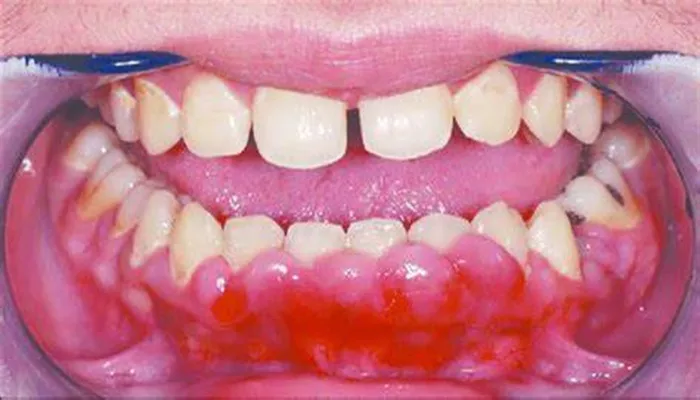Gingival hyperplasia, also known as gingival overgrowth or hypertrophic gingivitis, is a condition characterized by the excessive growth of gum tissue around the teeth. This condition can lead to various complications, including difficulty in maintaining oral hygiene, increased risk of periodontal diseases, and aesthetic concerns such as a “gummy smile.”
Understanding the causes of gingival hyperplasia is crucial for effective management and prevention. This article will delve into the various factors that contribute to this condition, providing a comprehensive overview suitable for both dental professionals and patients.
What Is Gingival Hyperplasia?
Gingival hyperplasia refers to the abnormal enlargement of the gingiva (gums). It can occur in localized areas or affect the entire gum tissue surrounding the teeth. The condition can be asymptomatic in its early stages but may progress to cause discomfort, pain, and functional issues. The overgrowth of gum tissue can obstruct proper oral hygiene practices, leading to plaque accumulation and further periodontal complications.
Symptoms of Gingival Hyperplasia
Common symptoms associated with gingival hyperplasia include:
Swollen gums: The gums may appear enlarged and inflamed.
Tenderness: Affected areas may feel sensitive or painful.
Bleeding: Gums may bleed during brushing or flossing.
Bad breath: Accumulation of plaque can lead to halitosis.
Difficulty in oral hygiene: The overgrown tissue can make it challenging to clean teeth effectively.
Importance of Identifying Causes
Identifying the underlying causes of gingival hyperplasia is essential for effective treatment. Management strategies vary depending on whether the condition is drug-induced, inflammatory, systemic, or hereditary.
Causes of Gingival Hyperplasia
Gingival hyperplasia can arise from several factors, which can be broadly categorized into four main groups: inflammatory causes, medication-induced causes, systemic diseases, and genetic factors.
1. Inflammatory Causes
Inflammation is one of the most common contributors to gingival hyperplasia. The primary source of inflammation in the gums is plaque accumulation due to poor oral hygiene. When plaque builds up on teeth, it irritates the gum tissue, leading to:
Gingivitis: This is an early stage of gum disease characterized by redness, swelling, and bleeding of the gums. If left untreated, it can progress to more severe forms of periodontal disease.
Periodontitis: Chronic inflammation can lead to periodontitis, where deeper tissues are affected, potentially resulting in tooth loss.
The inflammatory response triggers an increase in fibroblast activity within the gum tissue, leading to excessive collagen production and subsequent gum overgrowth.
2. Medication-Induced Causes
Certain medications are well-documented causes of gingival hyperplasia. This condition often arises as a side effect of specific drug classes:
Anticonvulsants: Medications such as phenytoin (Dilantin) are known for causing gingival overgrowth in approximately 50% of patients who use them. Other anticonvulsants include phenobarbital and lamotrigine.
Calcium Channel Blockers: These drugs are commonly prescribed for hypertension and heart conditions. Notable examples include nifedipine (Adalat) and amlodipine (Norvasc), which have been linked to a significant incidence of gingival hyperplasia.
Immunosuppressants: Cyclosporine is another medication associated with this condition. It is often prescribed for organ transplant patients or those with autoimmune diseases.
The mechanism behind drug-induced gingival hyperplasia involves a combination of factors including direct effects on gingival fibroblasts and exacerbation by existing inflammation due to plaque accumulation.
3. Systemic Diseases
Several systemic conditions can contribute to the development of gingival hyperplasia:
Hormonal Changes: Hormonal fluctuations during pregnancy or puberty can lead to increased sensitivity and swelling of the gums.
Pregnant women often experience a condition known as “pregnancy gingivitis,” which may resolve postpartum.
Diabetes: Individuals with diabetes are at a higher risk for periodontal diseases due to impaired immune response and altered blood supply to the gums.
Vitamin Deficiencies: Deficiencies in vitamins such as Vitamin C (scurvy) or B vitamins can result in gum swelling and sensitivity.
Leukemia: Certain types of leukemia present with gingival hyperplasia as part of their clinical manifestation due to infiltration of leukemic cells into the gum tissue.
4. Genetic Factors
Hereditary conditions also play a role in gingival hyperplasia:
Hereditary Gingival Fibromatosis (HGF): This rare genetic disorder leads to progressive enlargement of the gums due to an overproduction of collagen. Symptoms often begin in childhood but may not become noticeable until adulthood.
Genetic predisposition affects how individuals respond to inflammation and medication, influencing their likelihood of developing gingival overgrowth when exposed to certain triggers.
Diagnosis And Treatment
Diagnosing gingival hyperplasia involves a thorough clinical examination by a dental professional who will assess the extent of gum overgrowth and inquire about medical history and medications being taken.
Treatment Options
Treatment for gingival hyperplasia varies based on its underlying cause:
Improving Oral Hygiene: For cases primarily caused by inflammation due to plaque buildup, enhancing oral hygiene practices through regular brushing, flossing, and professional cleanings can significantly reduce symptoms.
Medication Adjustment: If medication-induced hyperplasia is suspected, consulting with a healthcare provider about alternative medications may be necessary.
Surgical Intervention: In severe cases where conservative measures fail or if there is significant aesthetic concern, surgical options such as gingivectomy (removal of excess gum tissue) may be considered.
Management of Systemic Conditions: Addressing underlying systemic diseases through appropriate medical treatment can alleviate symptoms associated with gingival hyperplasia.
Conclusion
Gingival hyperplasia is a multifaceted condition that requires careful evaluation and management based on its various causes. By understanding these causes—ranging from poor oral hygiene practices leading to inflammation, through medication side effects, systemic diseases, and hereditary factors—patients and dental professionals can work together towards effective treatment strategies.
Related topics:

